Estimated Outlet Temperatures in Shell-and-Tube Heat Exchanger Using Artificial Neural Network Approach Based on Practical Data
Keywords:
Artificial neural network, Shell-and-tube heat exchanger, Outlet temperatures, training, validation and testingAbstract
The objective of this study is to apply Artificial Neural Network for heat transfer analysis of shell-and-tube heat exchangers widely used in power plants and refineries. Practical data was obtained by using industrial heat exchanger operating in power generation department of Dura refinery. The commonly used Back Propagation (BP) algorithm was used to train and test networks by divided the data to three samples (training, validation and testing data) to give more approach data with actual case. Inputs of the neural network include inlet water temperature, inlet air temperature and mass flow rate of air. Two outputs (exit water temperature to cooling tower and exit air temperature to second stage of air compressor) were taken in ANN.
150 sets of data were generated in different days by the reference heat exchanger model to training the network. Regression between desired target and prediction ANN output for training , validation, testing and all samples show reasonably values are equal to one (R=1) . 50 sets of data were generated to test the network and compare between desired and predicated exit temperature (water temp. and air temp.) show a good agreement ( ).
Downloads
Downloads
Published
Issue
Section
License
Copyright: Open Access authors retain the copyrights of their papers, and all open access articles are distributed under the terms of the Creative Commons Attribution License, which permits unrestricted use, distribution, and reproduction in any medium, provided that the original work is properly cited. The use of general descriptive names, trade names, trademarks, and so forth in this publication, even if not specifically identified, does not imply that these names are not protected by the relevant laws and regulations. While the advice and information in this journal are believed to be true and accurate on the date of its going to press, neither the authors, the editors, nor the publisher can accept any legal responsibility for any errors or omissions that may be made. The publisher makes no warranty, express or implied, with respect to the material contained herein.












